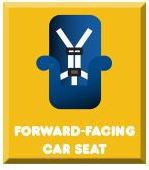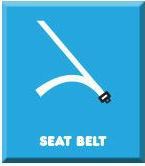Child Car Seats and Boosters
Staying Within the Law and Your Budget
In Georgia, motor vehicle crashes are the leading cause of death and injury for children ages 14 and under. The national statistics are sobering. In 2014, 1,070 children 14 and younger were killed and an estimated 167,000 were injured, according to the U.S. Department of Transportation. On average, 3 children were killed and an estimated 458 children were injured every day in the United States in traffic crashes.
The lack or improper use of car seats is a major contributor to this problem. According to the National Highway Traffic Safety Administration (NHTSA), four out of every 10 children under 6 who die or are seriously injured in auto accidents were unrestrained or improperly restrained; however, when car seats are used correctly they are 71% effective in preventing injury among infants and 54% effective with children ages 1-4.
Realizing the crucial role that car seats play in child safety, Georgia lawmakers passed laws and regulations pertaining to their use.
According to Georgia law:
- Children under age 8 must be properly secured in an approved car seat or booster seat while riding in:
- Passenger automobiles, vans, and pickup trucks
- Exemptions – taxicabs and public transit vehicles
- The car seat and/or booster seat must:
- Be in the rear seat
- Be appropriate for the child’s weight & height
- Meet all U.S. Federal standards
- Be installed and used according to the manufacturer’s instructions
Exemptions:
- Children under age 8 whose height is over 4’9” or 57”
- Parent or Guardian has a written statement from a physician that the child has a physical or medical condition that prevents restraining them as required by law. Parent or guardian should keep this statement in their possession.
Exceptions:
- A child under age 8 and weighing at least 40 pounds is not exempt from the law. They may use a lap belt only instead of a car seat or booster seat when:
- The vehicle is not equipped with lap and shoulder belts; or
- Excluding the driver’s seat, all seating positions with lap and shoulder belts are being used to restrain other children. In this case, placement of car seats / booster seats should be evaluated to determine if seats can be repositioned to provide the best protection for all children being transported.
A child under age 8 may only be in the front seat, properly restrained in a car seat or booster seat when:
- The vehicle has no rear seating position appropriate for correctly restraining a child, or
- All appropriate rear seating positions are occupied by other children.
Violating these laws can result in a fine of up to $50 and one point against your license per improperly restrained child. A second incident may double the fines and points.
Beyond the Law
Experts suggest several other tips to ensure your child’s safety while riding in a motor vehicle:
Always read and follow child restraint instructions for proper use of the child restraint system as well as the vehicle owner’s manual.
- Child restraints should be installed with no more than one inch of movement from side-to-side or front-to-back (tested at the belt path).
- Rear-facing child restraints should never be placed in front of an active airbag.
- Children should remain rear-facing until they reach the upper weight limit or height allowed by the seat.
- Children should remain in a booster seat until the safety belt fits them correctly across the hips and collar bone. (Usually when a child is approximately 4’9” and between 8 and 12 years of age).
- Children age twelve (12) and under should ride in the back seat of the vehicle whenever possible. The back seat is the safest position for children.
- Ensure that every occupant is properly restrained for every ride
- Return the product registration card provided for all new child safety seats to the manufacturer to ensure you will be notified of any recalls.
- Check www.recalls.gov to inquire about recalls or safety notices on child safety seats.
- Avoid purchasing safety seats from yard sales, flea markets and second hand stores or when there is no known history of the seat
Car Seat Use After a Crash
NHTSA recommends that car seats be replaced following a moderate or severe crash in order to ensure a continued high level of crash protection for child passengers. Car seats do not automatically need to be replaced following a minor crash.
A minor crash is one in which ALL of the following apply:
- The vehicle was able to be driven away from the crash site.
- The vehicle door nearest the car seat was not damaged.
- None of the passengers in the vehicle sustained any injuries in the crash.
- If the vehicle has air bags, the air bags did not deploy during the crash; and
- There is no visible damage to the car seat.
NEVER use a car seat that has been involved in a moderate to severe crash. Always follow manufacturer's instructions.
When Shopping for a New Car Seat
- Buy a car seat that can be installed and used correctly every time.
- Use a car seat that fits your child’s current size and weight
- Not all car seats fit in all vehicles. Make sure the car seat is the right fit for your vehicle. If possible test the car seat you plan to buy to make sure it fits well with your vehicle.
- Use www.safercar.gov/parents ‘car seats’ to narrow down your search by comparing car seat makes and models.
Car Seat Types
Rear-Facing Car Seat
The following are types of rear-facing car seats:
Infant Car Seat (Rear-Facing only): Designed for newborns and small babies, the infant-only car seat is a small, portable seat that can only be used rear-facing. Babies usually outgrow their infant car seats by eight or nine months. When that happens, we recommend that parents purchase a convertible or all-in-one car seat and use it rear-facing.
- Convertible Seat: As a child grows, this seat can change from a rear-facing seat to a forward-facing seat with a harness and tether. Because it can be used with children of various sizes, it allows for children to stay in the rear-facing position longer.
- All-in-One Seat: This seat can change from a rear-facing seat to a forward-facing seat (with a harness and tether) and to a booster seat as a child grows. Because it can be used with children of various sizes, it allows for children to stay in the rear-facing position longer.
Forward-Facing Car Seat

- Convertible Seat: As a child grows, this seat can change from a rear-facing seat to a forward-facing seat with a harness and tether.
- Combination Seat: As a child grows, this seat transitions from a forward-facing seat with a harness and tether into a booster.
- All-in-One Seat: This seat can change from a rear-facing seat to a forward-facing seat (with a harness and tether) and to a booster seat as a child grows.
Booster Seat
Boosters seats position the seat belt so that it fits properly over the stronger parts of your child's body. Types include:
Booster Seat with High Back: This type of booster seat is designed to boost the child’s height so the seat belt fits properly. It also provides neck and head support and is ideal for vehicles that don’t have head rests or high seat backs.
- Backless Booster Seat: A backless booster seat is designed to boost the child’s height so the seat belt fits properly. It does not provide head and neck support. It is ideal for vehicles that have head rests.
- Combination Seat: As a child grows, this seat transitions from a forward-facing seat with a harness into a booster.
- All-in-One Seat: This seat can change from a rear-facing seat to a forward-facing seat (with a harness and tether) and to a booster seat as a child grows.
 Seat Belt
Seat Belt
Should lie across the upper thighs and be snug across the shoulder and chest to restrain your child safely in a crash. It should not rest on the stomach area or across the neck or face.
Installation and Inspection
The majority of parents believe that their child’s car seat is properly installed, but according to NHTSA, eight out of 10 car seats are installed incorrectly. SAFE KIDS Burke COUNTY operates a FREE Child Safety Seat Inspection Station to assist parents and care givers with properly installing their car seats. FREE Car Seat Check Events, classes and presentations are also offered regularly in the community. Please call 912-200-7852 for more information and to schedule an appointment

 Burke County Sheriff
Burke County Sheriff
